
34 minute read
I A New Chapter
• BUSINESS •
A NEW CHAPTER
Advertisement
Samah Abdulaziz Algosaibi, Executive Board Member for prominent Saudi family group Ahmad Hamad Algosaibi & Bros, reveals details of its $1.9 billion resolution of a 12-year-long battle with its creditors and sets out its latest plans for the future.
BY NERMEEN ABBAS
Samah Abdulaziz Algosaibi, Executive Board Member at Ahmad Hamad Algosaibi & Bros.
In September 2021, Saudi Arabia witnessed the end of a 12-year debt dispute between notable family business Ahmad Hamad Algosaibi & Bros (AHAB) and its creditors, with the latter agreeing to a $1.9 billion settlement offer. It was the final conclusion of a saga that began when AHAB, together with the Saad Group, defaulted on joint debts to banks worth $22 billion in 2009, with the Algosaibi family since engulfed in a drawn-out battle amid allegations of fraud.
Executive Board Member for AHAB, Samah Abdulaziz Algosaibi, says the family is now looking forward to a return to normal life and regaining control over the business. “It was like a dream come true,” says Samah, who played a key role in the negotiations. “We were all together when the court announced that nearly 95% of creditors approved the deal. The whole family welcomed the news with joy and tears.” It’s a welcome close to a prolonged nightmare for the Algosaibi family. While restrictions had prevented the investment holding company from making new investments or raising finance for its owned assets for over a decade, it can now once again operate its business and focus on expansions.
AHAB was first established in Saudi Arabia in the 1940s by founder Hamad Ahmad Algosaibi. Ownership of the business—which generates around $267 million in annual revenues and works across the construction, energy, manufacturing, hospitality, transport, and consumer sectors through its subsidiaries—is today divided equally between the families of the founder’s late sons, Abdulaziz, Ahmed, and Sulaiman Algosaibi.
The recent dispute has centered around a conflict between the Algosaibi family and Maan Al-Sanea—a sonin-law of Abdulaziz Algosaibi and the owner of the Saad Group, a diversified holding company. Previous chairman of AHAB, Sulaiman Algosaibi, and Al-Sanea were both among Forbes’ billionaires in 2007, but two years later AHAB and the Saad Group defaulted on more than $22 billion in combined debt, which they owed to well over 100 regional and international banks.
The Algosaibi and Al-Sanea families have been playing the blame game ever since their financial downfall, as creditors have continued to pursue the two Saudi conglomerates. The Algosaibi family claim to be victims of a $9 billion fraud orchestrated by Al-Sanea, who they say had complete control of the financial business of AHAB at the time. Al-Sanea was arrested and detained in 2017 for unpaid debts—at the time of writing, he had continued to deny all accusations against him and had not been sentenced in Saudi Arabia. Forbes Middle East tried to reach out to a representative of Al-Sanea but was unable to make contact.
While the authorities in Saudi Arabia continue to detain Al-Sanea, the Algosaibi family has become one of the first-ever to reach a deal with creditors under the umbrella of the bankruptcy law that the kingdom approved in 2018. The Saudi court approved 139 banks as AHAB’s creditors and, on September 7, 2021, they agreed to settle for $1.9 billion, which accounts for 26% of the total approved debt claims of $7.3 billion. The deal includes $1.25 billion in cash dividends and liquid shares that will be distributed almost immediately, followed by $667 million in the form of real estate assets in Saudi Arabia. AHAB will contribute $1.4 billion, while Algosaibi’s partners will personally provide another $533 million. While 25% of claims are from Saudi banks, the remaining 75% are split between international and GCC banks.
“Part of the $1.9 billion settlement comes from the group, and the remaining amount is from the family. We gave up a large number of assets, but we had to put an end to this case to be able to rebuild and move forward,” explains Samah, who became the first woman to join the family business in 2011—two years after the case erupted.
She reveals that the court approved the settlement on September 15, 2021, and provided a 14-day window for objections to be filed. That 14-day period expired on September 29, 2021, at which point the order became final with no appeals, and the process of lifting all restrictions that affected the company and shareholders could begin. The Algosaibi family will now start to pay the settlement, with the group making the first payment by selling its shares in public companies in Saudi Arabia. It will also create a fund owned by creditors to manage its real estate assets. “This is not a liquidation; we are not auctioning assets. It is an organized sale through a fund owned by creditors,” clarifies Samah.
While AHAB, led by an executive team appointed in 2013, has relinquished the majority of its real estate assets
under the settlement terms, Samah confirms that the company has maintained most of its operating assets and several major properties. “The ability to continue doing business was a high priority to us, as we are looking forward to rebuilding the group, which embraces thousands of employees,” says Samah. According to the executive board member, the total assets that remain in the group, including properties and operational assets, are valued at around $157.3 million, with its employees and family members numbering over 3,500.
It’s been a long and arduous journey for AHAB. “Algosaibi’s case was one of the largest and most complicated debt disputes in the Middle East,” says Eyad Reda, Managing Partner of the Riyadh-based Eyad Reda Law Firm. “The settlement will affect the investment climate by restoring the financial stability of the Algosaibi Group and will also achieve support for the creditors’ business by pumping cash into the market,” explains Yaseen Khalid Khayyat, lawyer & legal consultant at Yaseen Khalid Khayyat Law Offices in Jeddah. He considers the $1.9 billion settlement “a fair deal,” even if it does not achieve the creditors’ aspirations. “[It] may be fair at this time, given the seriousness of the partners in paying part of the indebtedness amounts,” Khayyat adds.
Behind the scenes, the battle has been both personal and professional for the Algosaibi family. The story began when Al-Sanea married Samah’s elder sister in 1980. At the time, according to a 2009 report by the Wall Street Journal, he was a young fighter pilot from Kuwait and an “up-andcomer” in the Gulf. Welcomed into the family, Al-Sanea was put in charge of AHAB’s financial services businesses, and in 1980 he established the Saad Group, with interests in banking, construction, healthcare, and education. According to a 2019 report by the Kuwait Financial Centre “Markaz,” AHAB founded The International Banking Corporation (TIBC) in Bahrain in 2003, with Al-Sanea as its managing director. And by 2007, Al-Sanea was the largest non-institutional shareholder in HSBC.
According to the Markaz report, AHAB’s money exchange division went on to borrow large sums from global banks, most of which were routed through TIBC. In 2009, amid the turmoil of the global financial crisis, TIBC defaulted on $2.2 billion in loan payments and, as a direct fallout, the money exchange division of AHAB too defaulted. At the same time, according to reports by Forbes, Al-Sanea also defaulted on debt and announced plans to restructure an unspecified amount of Raef Elhassan, Chief Operating Officer at AHAB; Simon Charlton, Chief debt at the Saad Group, Restructuring Officer at AHAB; and Brett Walter, General Counsel at AHAB. blaming turmoil in the Bahraini banking sector and a “short-term liquidity squeeze.” The Algosaibi and Al-Sanea families became locked in dispute, with the former filing claims that it was the victim of a $9.2 billion fraud perpetrated by Sanea. According to the Wall Street Journal report, the Algosaibi family alleged that Al-Sanea forged family members’ signatures to receive loans, falsified the books of family companies, and siphoned AHAB funds into his Saad Group companies. Simon Charlton, Chief Restructuring Officer and Acting CEO of AHAB, says that Al Sanea claimed to leave TIBC in 2004 after establishing the Awal Bank in Bahrain. “Al Sanea purported to resign from TIBC and also AHAB’s money exchange, but he continued to control the money exchange and TIBC for many years, not two years, and even when he claims he resigned he still retained firm control,” maintains Charlton. A spokesman for Al Sanea told Forbes in June 2009 that he had “no involvement whatsoever” in TIBC either personally or through Saad Group. Reaching a deal with its creditors proved difficult from the beginning for the Algosaibi family. As it initially tried to negotiate with the banks involved, Samah reveals that some encouraged the group to settle with them individually and exclude the remaining creditors. “We refused as we have creditors from so many countries around the world, and we wanted a final and comprehensive settlement,” she insists. AHAB tried to negotiate again in 2014 after appointing a restructuring
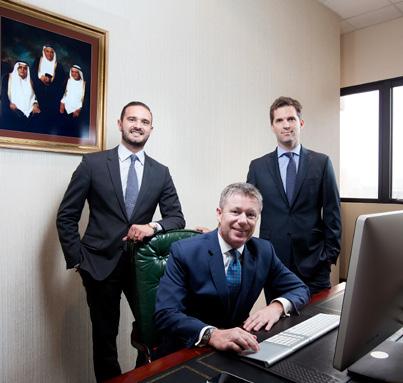
team. A meeting was held in Dubai, and the negotiation progressed, with 60% of creditors supporting a settlement. However, a lack of regulations that would allow a “cram down” of dissenting creditors blocked the company’s way at that time. As time went on, AHAB lost some notable brand partnerships due to the business restrictions. “Pepsi was a major dealership that we lost during the dispute after a 50-year-old relationship,” reveals Samah. “It was a huge loss, as a long history left with it.”
A lifeline surfaced when the Saudi government announced that it was working on a bankruptcy law. “The family members followed the news of the much-awaited law,” recalls Samah. “It played a key role in reaching a deal that guarantees the creditors’ rights and allows the company to continue operations.” Once the law was approved in 2018, the group submitted its application for a restructuring procedure. “We were one of the first companies to file for financial restructuring in the kingdom, and I think we paved the way for whoever comes after us,” says Samah. AHAB’s application for a financial restructuring settlement proposal was accepted in May 2019.
Eyad Reda believes that Saudi’s new bankruptcy law, and the conclusion of the Algosaibi case, has opened a window for troubled companies to continue operations instead of being forced to close down, with 392 companies submitting requests under the bankruptcy law as of the end of 2020. “There are similar cases that the bankruptcy law could put an end to, such as Saad Hariri’s Saudi Oger, which became bankrupt following the fallout of the construction and real estate sector, resulting in over 60,000 claims and debts that are still being counted,” he adds.
While AHAB has closed one chapter, it is still pursuing a case against Al-Sanea, claiming that his management led to the debt crisis. “He submitted a request for restructuring under the bankruptcy law and, like other creditors, we filed a lawsuit against him to reclaim our money,” Samah reveals. She also confirms that no business or commercial ties remain between the Algosaibi family and Al-Sanea. “The family has decided to take the responsibility and pay the debt, though it was a hard decision as we didn’t take this money,” says Samah.
Despite this, the Algosaibi family can now look ahead. While the dispute greatly impacted the group’s ability to put long-term plans in place, Samah, whose roles include monitoring business performance, seems optimistic about the future. She says that management will now focus on the business’s main sectors, including oil and gas services, power, food, hospitality, shipping, logistics, and manufacturing. The group’s notable subsidiaries include Tecmo Arabia, Crown Arabia, The Arabian Pipecoating Company, IACC and Solar Arabia, among others.
AHAB is now looking to establish new companies, but despite a lack of liquidity hindering expansion plans that require capital, the family intends to keep the group private. “There is no final plan yet, but we are not considering an IPO. Instead, we will probably approach financing from banks,” says Samah. The current management will continue to lead the company, and new experts will be hired if needed. Samah explains that the group has been working on corporate governance with participation from what she described as an “elite group of young family members.”
As the family enters a new era, the next generation has a lot to learn from Samah. She first joined the family group 10 years ago when it was uncommon for Saudi women to work in the private sector. “Things have changed since then,” she assures. “Today, we have a lot of female employees from inside and outside the family.” Samah remembers the moment when her cousin and the chairman Yusuf Algosaibi invited her to join the group. “He asked me if I wanted to work in the group, and I responded immediately: Are you serious? When do I start?” Although she didn’t know much about the group’s activities then, she spent her first few months in the business studying the files of subsidiaries. And, as time passed, she became central to the settlement negotiations. Learning fast, she soon took the lead in the negotiations with the creditors and acted as the link between the executive team and the family.
Now, as the family gets back to business and eagerly waits for its travel ban to be lifted, Samah is steadfast in her commitment to AHAB’s future in the kingdom. “We have a lot of responsibilities and plans here,” she admits. “But we will make up for the past 12 years.”
Stay connected with our latest business news.
Still Finding Opportunities
OMANI LEADERS’ INSIGHTS
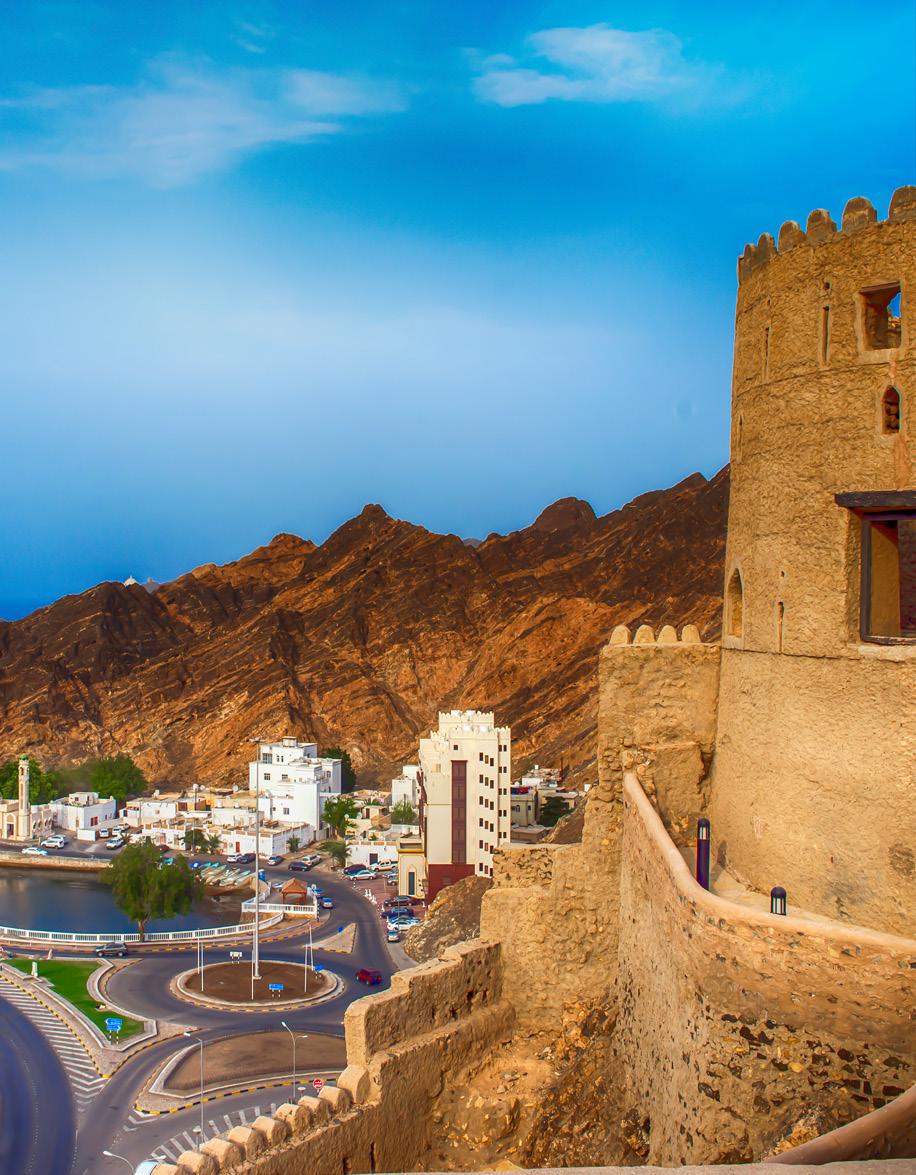
The Omani Economy: Reforms And Challenges
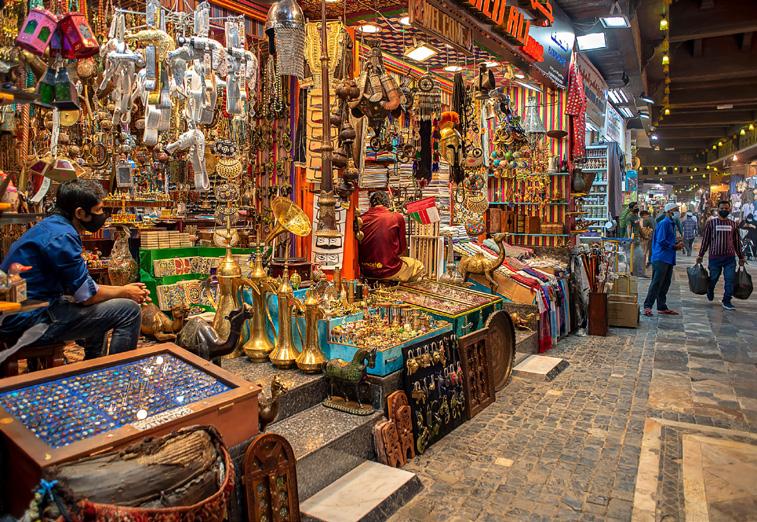
The GCC countries have dually suffered from an economic downturn as a result of the pandemic and an oil price crash. While these have widened the budget deficits of most GCC states, different countries have had varying responses, with Oman implementing tough austerity measures.
2020 was a year of major changes for Oman. In January 2020, Sultan Haitham bin Tariq Al Said succeeded Sultan Qaboos as the ruler of Oman. Just months later, Oman’s government took steps early to support the sultanate’s economic growth and contain the spread of the pandemic by closing nonessential businesses and introducing social distancing requirements and border restrictions.
Fiscal measures included interestfree emergency loans, waiving or reducing selected taxes and fees, giving the flexibility to pay taxes in installments, and establishing the Job Security Fund to support citizens who had lost their jobs. According to the IMF, the Central Bank of Oman also lowered interest rates and liquidity injections, deferred loan installment payments, and relaxed macro-prudential requirements on capital buffers and liquidity ratios. Furthermore, Sultan Haitham bin Tariq also announced $779.2 million worth of development projects.
A tough year However, it was still a challenging year for Oman, with more policies needed to target sustainable long-term growth. In May 2020, Fitch Ratings affirmed Oman’s Long-Term Foreign-Currency Issuer Default Rating (IDR) at ‘BB-’ with a negative outlook. The negative outlook reflected “risks to sustained enactment of fiscal consolidation plans given the challenging economic and social context.” Then, in October 2020, S&P Global Ratings downgraded Oman’s sovereign ratings for the second time that year to “B+” from “BB-” with a stable outlook.
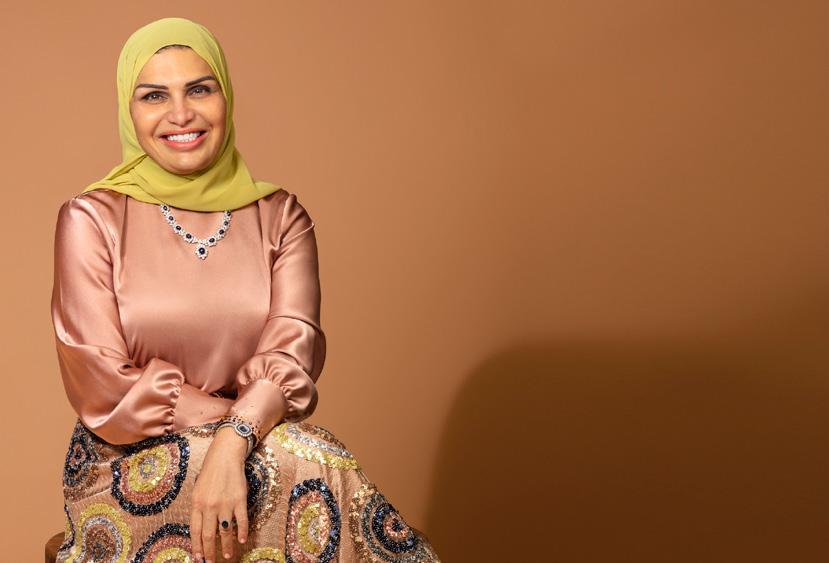
Versatility – The Hallmark Of Great Leadership
Hon. Lujaina Mohsin Haider Darwish, Chairperson of Infrastructure, Technology, Industrial and Consumer Solutions at Mohsin Haider Darwish (MHD), is growing a business, contributing to Oman’s economy, and nurturing a new generation of female talent.
As MHD’s chairperson for Infrastructure, Technology, Industrial and Consumer Solutions (ITICS), how did you lead the cluster during the pandemic? As the pandemic unfolded, it became clear to me that urgent action was needed in three areas. The first was to reduce the risk to our employees and their families, the second was to ensure business continuity, and the third was to help support the community in mitigating the effects of the pandemic.
To protect our people, we implemented essential safety precautions mandated by the health authorities in Oman, as well as those recommended by international agencies. As for business continuity, we stepped up our efforts to service our customers. We worked out innovative distribution methods during the lockdown, ensured uninterrupted availability of working capital, and built trust with our suppliers and contractors by not reneging on any of our payment commitments. All this created immense goodwill and I am proud to say that we were one of the very few business entities that closed 2020 almost 100% on budget.
With regards to supporting the community, we reaffirmed our CSR commitments and did not halt any activity due to the crisis. Also, in spite of the pandemic, we retained all our employees and continued recruitment in accordance with our manpower planning budget.
MHD was recently split into two clusters. As chairperson of the ITICS cluster, how do you plan to contribute to the company’s growth moving forward? The primary reason for bifurcating the company’s operations into two business clusters was to enable accelerated growth. Over the last few months, my team and I have been working on numerous plans for expansion – organic and through acquisitions – some of which have already come to fruition. Several of our business units have added new product categories and brands, entered into new areas of business,
and engaged with state-owned entities to work on projects through public-private-partnership models.
We have also entered into negotiations to acquire businesses in overseas territories that have synergies with our present operations. We are constantly searching for new opportunities, and several projects are discussed every month.
I believe these actions will contribute to the overall growth of the family business in the long run. What does it take to be amongst the region’s most powerful businesswomen? I believe that the courage of your convictions is the primary requirement. The ability to chase your dreams with complete faith, despite constraints and setbacks, is the hallmark of a true business leader. Persistence and determination are also vital characteristics. By having a clearly defined plan and rigorously following their chosen paths, ignoring the
contrarian voices around them, women business leaders can establish themselves among the powerful leaders in the region.
How have you contributed to the growth and safety of Omani society since the start of the pandemic? Ensuring the safety of our employees and their families during the pandemic has also contributed to the safety of our suppliers, contractors, and society at large. In addition, our ongoing CSR activities, our training programs conducted by the MHD Training Institute, our recruitment of Omani nationals, and our involvement in critical projects, all contribute positively to the economy.
As one of the seven female members of Oman’s consultative council and a member of the state council, how do you represent Omani women on the political and economic scene? This is something very close to my heart and a considerable part of my time is spent on promoting women’s causes and highlighting the achievements of women in Omani society. I work closely with people in both official and non-official circles to build an ecosystem that encourages women to be active in economic and political spheres. How do you keep inspiring women, both as a business leader and as a woman? In my opinion, women like me who are in the public eye have a moral obligation to guide and inspire the younger generation of women, and help them realize their dreams. I try to set an example for other women in everything I do, whether it’s speaking at public events, working for women’s causes, carrying out charitable activities, or promoting the achievements of other women in various fields. I also make myself available to young entrepreneurs for personal consultation, and I encourage women to enter domains dominated by men, so that they can go on to be role models for others.
You have achieved so much over the years. Which of your recent personal achievements are you most proud of?
Scan this QR code to open the website
My late father, Mohsin Haider Darwish, always encouraged me to contribute to Oman and the larger community. It’s a great honor for me to be elected as a member of the Majlis A Shura and Majlis A’Dawla and to be bestowed with the wonderful opportunity to serve Oman.
I have also been elected to the board of the Oman Football Association (OFA), which gives me a chance to help develop the game at the grassroots. I am committed to working with the board of directors under the able guidance of Salim bin Said Al Wahaibi, the Chairman of OFA, to help Oman football scale new heights.
I am a strong believer in women’s empowerment too, which was fostered by the late His Majesty Sultan Qaboos bin Said, and which is now being taken forward by His Majesty Sultan Haitham bin Tariq. Working on the development of women’s football and a women’s trekking group are two of the initiatives that will help fulfil my dream of furthering women’s empowerment and building an inclusive society. I have also been involved in building awareness around the achievements of young Omani women.
Besides the above, I am fortunate to have been involved with associations that aim to build friendly relations between Oman and other countries.
www.mhdoman.com
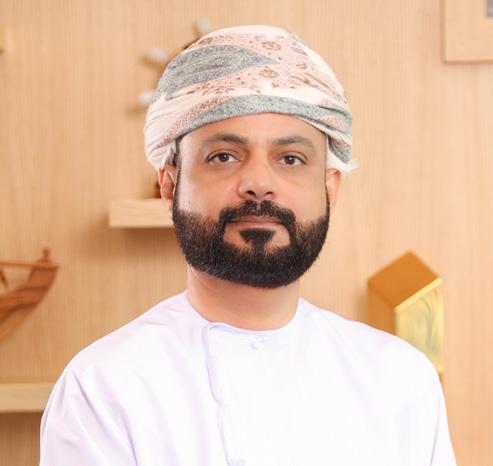
Digitizing A Nation
Talal Said Al Mamari, CEO of Omantel, explains how the company is helping to shape Oman’s digital future.
How is your latest initiative, Omantel Innovation Labs, contributing to Oman’s vision for the future? Omantel Innovation Labs are contributing to Oman’s Vision 2040 by promoting innovation and entrepreneurship in new and emerging technologies. For this initiative, Omantel is leveraging its expertise, partnerships, reach, and access to technology to accelerate the growth of relevant Oman-based technology start-ups across five technological verticals: 5G, Internet of Things (IoT), cybersecurity, customer experience technology, and big data.
The initiative aims to speed up the development and deployment solutions to Oman- and Omantelcentric challenges. They also aim to put the company at the heart of Oman’s emerging culture of entrepreneurial growth through digitization.
Talal Said Al Mamari, CEO
How is Omantel contributing to the start-up ecosystem in Oman? In addition to Omantel Innovation Labs, we are supporting nation-wide initiatives on start-ups by taking two broad approaches: support through training and capacity building, and support through services.
In cooperation with a number of other organizations and government ministries, Omantel has launched Upgrade, a multi-sectoral initiative to transform graduating students’ class projects into financially viable ICT start-ups. Meanwhile, the Edlal program on entrepreneurship, co-founded by Omantel, has been providing unique courses to startups, students, employees, and job seekers since 2017.
What’s more, Omantel offers a suite of specialized telecommunications services to match the needs of small but growing businesses.
How is Omantel enabling future industries like Fintech and the Internet of Things? Omantel’s digital wallet ‘eFloos’ is a great example of Fintech. The digital wallet enables its users to perform fund remittances with users of other digital wallets or banks in the sultanate. In addition, the company has introduced Teamway, a product that offers a smart point of sale (POS) service with integrated enterprise resource planning (ERP). The product automates financial processes for SMEs and enables the sector to embrace digital transformation.
Furthermore, by partnering with global firms, Omantel and its IoT subsidiary company, mOmkin, are enhancing IoT and machineto-machine infrastructure, and delivering e-services, portal content
management, and enhanced levels of network optimization and security. Meanwhile, on the capacitybuilding front, Omantel’s initiatives include the Internet of Things lab, a collaboration with Sultan Qaboos University and mOmkin. The company has also enabled Oman’s and the Middle East’s first artificial intelligence and IoTpowered e-Dukkan Store, introducing a cashless, grab-and-go shopping experience to the region.
How is Omantel promoting digital inclusion? Digital experiences have become a way of life and digital inclusion is achieved by extending telecom services to every member of society. To this end, Omantel has close to 100% service coverage, with highspeed internet reaching even the most remote areas. In addition, Oman has a robust digital policy and legislation in place, which Omantel lends its support to.
The company has also provided Fourth Industrial Revolution (4IR) technologies such as IoT, artificial intelligence, smart cities, block chain, and most recently, the 5G network. We partner with various world-leading firms, too, to make communications technology more achievable, accessible, and affordable.
What has Oman’s approach been to 5G rollout? Oman has embraced 5G in all prominent sectors. The rollout began in 2019, starting with fixed home broadband before introducing it for mobile phones in the first quarter of 2021 – Oman’s first network operator to do so. This technology is supporting the sultanate’s digital transformation and will pave the way for achieving objectives of Oman Vision 2040.
Scan this QR code to open the website
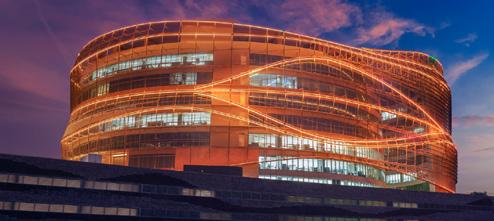
Omantel has piloted two major 5G projects in Oman’s transport and logistics sector that showcase the use of 5G infrastructure beyond network speed and efficiency, and it recently conducted a successful test of the 5G mmWave, which promises to help the company meet future demand for high quality connectivity.
What community initiatives is Omantel focusing on? Omantel’s CSR strategy is defined by four focus areas: education, entrepreneurship, community wellbeing, and environment.
On the topic of education, Omantel has always contributed towards a digitally competent society in which everyone has equitable access to quality education and technical and vocational training.
For entrepreneurship, Omantel ensures sustainability of new funding and incubation programs in ICT and 4IR, and it offers access to state-ofthe-art technologies and services. It also supports women’s empowerment and engages in social partnerships that lead to opportunities for sustainable incomes and jobs.
Meanwhile, as part of its responsibility towards the community, Omantel has always contributed towards increasing awareness regarding health and lifestyle issues, and it recently played a vital role in supporting the community when COVID-19 hit. The company procured COVID-19 testing kits, launched virtual clinics in cooperation with Royal Hospital and introduced G Suite for Education for remote learning. These are just a few examples of its commitment to society.
Last but not least, environmental initiatives are close to Omantel’s heart. These include supporting waste reduction and management initiatives, raising awareness on environmental issues, and enabling infrastructure that supports the environmentally friendly development of Oman. The Omantel HQ itself is an example of sustainable practices, and became the first building in Oman to obtain the LEED Platinum certification.
www.omantel.om
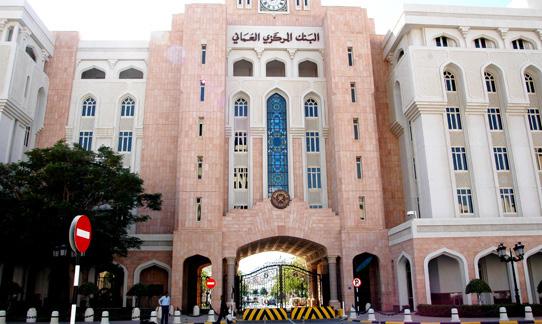
This comes as a result of Oman’s financial position, which was one of the weakest compared to its oil-rich Arabian Gulf allies. The country’s GDP contracted by 6.4% in 2020, with the construction, hospitality, and wholesale and retail trade sectors suffering the worst downturns. The non-hydrocarbon GDP is estimated to have contracted by 10%. The GDP at current prices was down by 2.5% in the first quarter of 2021, as oil activities declined 20.6%, while the non-oil sector was up by 5.7%, the ministry said, according to a Reuters report. Meanwhile, Oman’s budget deficit increased to 18% of GDP in 2020, with the nation’s 2021 budget deficit estimated at about 8% of GDP ($5.7 billion). The latest economic data shows that Oman’s budget deficit stood at $2.1 billion in the first four months of 2021, compared to a budget surplus of $348.6 million during the same period in 2020. It reached $2.3 billion in May.
On the tourism and hospitality front, hotels in the three-to-five-star category in Oman recorded total revenues of $222.8 million by the end of December 2020, falling 62.9% compared to 2019’s $569.2 million revenue. The number of passengers traveling through the airports of the Sultanate of Oman declined by 74.3% in 2020, compared to the same period in the previous year.
Policies and plans To try to plug its widening budget deficit, the government of Oman has been raising money from different entities, with public debt expected to reach more than $56.4 billion in 2021. It has announced several bond issuances in the last year, with the latest issuance coming in January 2021. The issuance was its third in just three months, selling $3.2 billion in bonds. The Gulf nation has also withdrawn $1.5 billion from its sovereign wealth fund, the Oman
Central Bank of Oman
Investment Authority, and has reportedly received $1 billion in direct financial support from Qatar.
Oman has also created a new state-owned energy company in an effort to use its largest oil block to raise debt. The new energy firm, Energy Development Oman, will own a stake in Petroleum Development Oman as well as an interest in Block 6. It will be headed by Haifa Al Khaifi as CEO. It’s reportedly in talks with banks to raise $1.5 billion.
Oman has introduced a number of proactive policy measures to address its economic woes, with Oman’s Ministry of Economy publishing details for its tenth five-year development plan, 2021-2025, earlier this year. The plan seeks to boost the economy, develop a macroeconomy environment, upgrade the performance of general finance as well as rationalize public spending and promote disciplined financial policy that achieves sustainable growth. It will also form the base budget for the National Vision 2040.
Oman is currently developing a unified financial system that will incorporate all associated financial transactions of government units and their budgets. The ministry said the system aims to enhance public spending management, promote financial control, and integrate financial systems and processes in all government units. It is also developing an interactive platform that seeks to improve public finance and achieve its sustainability. This involves enhancing community participation and the national register of government assets.
In an effort to address rare protests over unemployment, Sultan Haitham announced a plan to create more than 32,000 jobs for Omanis during 2021, with 12,000 in the government’s civil and military establishments. This comes in addition to earlier job creation efforts where it was announced that certain job categories in the private sector would be completely nationalized in Oman. Work permits for expats in these professions will not be renewed after their expiration.
Major changes are also happening in the form of labor law reformations for expats. This includes the abolition of the requirement for expat workers to obtain a permit to transfer to a new employer, which was known as “the no-objection certificate system.” The country has seen an exodus of foreign workers with more than 270,000 expat workers in Oman leaving the country in the first 11 months of 2020.
Mohsin Hani Al Bahrani, CEO of the Automotive, Construction Equipment and Renewable Energy (ACERE) cluster of Oman’s Mohsin Haider Darwish Group (MHD)
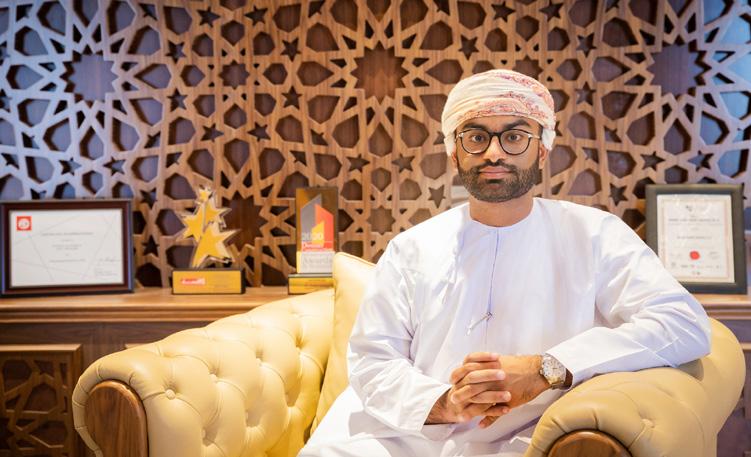
Fueling Growth
“If the tide of the time is against you, keep marching on.” This was the motto of Mohsin Hani Al Bahrani when he took over as CEO of the Automotive, Construction Equipment and Renewable Energy (ACERE) cluster of Oman’s Mohsin Haider Darwish Group (MHD). Now, his resilience and judgment are paying off.
What was the situation like when you assumed the role of CEO at MHD ACERE, and what changes have you overseen? I joined MHD as the Director of Automotive. After a year, I was promoted to CEO, at a time when the pandemic was challenging the economic health of Oman. However, drawing on my business acumen and resilience, I was able to bring in niche brands such as McLaren Automotive, ABB EV Chargers, Varta Batteries, XCMG, and Weir Trio. This created much needed employment opportunities for the country and contributed to socio-economic development. Beyond the pandemic, I have also expanded the sales and aftersales network for MHD ACERE, setting up seven new sales facilities across Oman and increasing our aftersales facilities from three to 12 in the space of two years. I was also instrumental in merging together the Tyres and Batteries division with Automotive to ensure the growth and expansion of brands such as Michelin, BF Goodrich, Riken, and Eneos. Where automotive is concerned, I have also been active in promoting MG Motors in the sultanate. In 2019, the brand ranked 15th in terms of local sales volume, according to the MEAC Report. Now, it occupies third position, behind Toyota and Nissan.
What role has e-commerce played in helping you navigate the challenges of the COVID-19 pandemic?
My approach to handling business in the wake of the ongoing COVID-19 pandemic is to turn these challenging times into an opportunity to assess and restructure our approach to customer service. I have deployed a number of innovative ideas through which MHD ACERE has overcome challenges. One such initiative has been the launch of e-commerce operations for MG Motors, where consumers can purchase a car in just three clicks. This launch was intended to help MG reach a wider customer base and maintain a continuous relationship with current customers and partners. In addition, to provide a premium, personalized experience to our niche customers, I enhanced the e-commerce platform of Jaguar Land Rover. These moves have enabled MHD ACERE to achieve its goals of delivering utmost customer satisfaction and improving overall brand awareness.
How have you helped your country during the pandemic, and how important is it to you that MHD ACERE supports Oman’s broader socio-economic development moving forward? It’s very important to me. After helping MHD ACERE regain leadership status in the commercial vehicles market with Ashok Leyland, I didn’t think twice about converting Ashok Leyland buses into mobile covid testing units to help curb the spread of the pandemic.
Meanwhile, as a commitment to my country, I have also been a champion of Omanization within the organization and I have ensured that the target of 65% Omanization set by the Ministry of Labour is successfully adhered to within MHD ACERE. Last year alone, I was directly involved in hiring 107 Omani employees into the company. You have received numerous awards and accolades for your achievements to date. How do you feel about this recognition? I was awarded a certificate of appreciation by SAIC Motor Middle East for outstanding sales where MG is concerned, and I have received recognition and awards
Scan this QR code to open the website
and Sonosite, to bring some of the best medical equipment and practices to the sultanate. This HospiCare division of MHD ACERE also supplies intra-aortic balloon catheters, hernia repair meshes, and other vital equipment to top medical organizations and hospitals in the country.
from multiple publications and institutions in the region. I was also recognized amongst the top 50 prominent personalities in Oman who have contributed directly towards the growth of the nation, and I was the only person under the age of 30 to achieve this feat. I am proud of these achievements and feel like they are a testament to the immense amount of work I have put in to take the business to new heights. Looking ahead, I am committed to continuing that hard work for the benefit of the company and of Oman. Guiding my work is my belief that economic diversification and tourism promotion are extremely crucial for the economic progress of the nation.
What is your strategy where business diversification is concerned? What sectors are currently of interest? I have diversified our business operations into new verticals by setting up MHD Leasing L.L.C, which caters to the tourism industry within the country. The newly formed Healthcare division is under my remit too, and we have partnered with some of the leading global brands in the medical sector such as Spark Meditech, Comen, Schrack Seconet AG, FUJIFILM, Renewable energy also falls under the ACERE umbrella. What are you doing to drive innovation, promote renewable alternatives, and support the battle against climate change? To tackle the immediate threat of global warming and climate change, I have introduced sustainable business practices to MHD ACERE. I have also established the Renewable Energy and Electric Vehicle Chargers Division. The aim of the division is to drive technological innovation, powered by clean energy. In addition, I have signed a contract with ABB, a pioneering technology leader focused on digital industries, for the supply of high-power electric vehicle chargers that will be installed across the country. There is no doubt that e-mobility is growing across the globe and my aim is to be among the pioneers providing the best green and sustainable solutions in Oman.
www.mhdoman.com
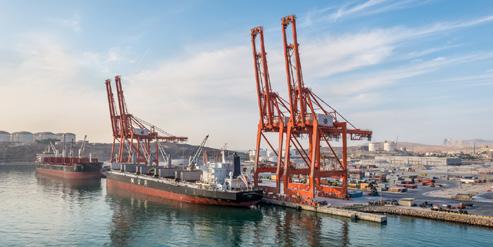
Port of Salalah in Oman
New taxes However, the biggest and perhaps toughest policy move would have to be the introduction of several taxes. Oman introduced VAT in April 2021, and is expected to become the first GCC country to introduce income tax on high income by 2022. The latter, which will target wealthy individuals, is expected to decrease the country’s deficit to 1.7% of GDP by 2024.
Oman was the fourth country in the GCC to introduce VAT, joining Saudi Arabia, the U.A.E. and Bahrain. It expects to amass $1 billion from VAT every year. However, in an effort to protect its most vulnerable people, Oman also announced a Social Security Scheme worth $259.8 million. It has also started removing utility subsidies from January 2021, with the aim of redirecting state subsidies to groups who need it, rather than subsidizing all users.
While the dual shocks took a heavy toll on Oman’s economy, its long-term policies aimed at sustainable growth, coupled with the roll-out of vaccinations and the easing of social distancing restrictions, are expected to ease its recovery process. The IMF expects Oman to experience a mild recovery of 1.5% in non-oil GDP growth in 2021, rising to 4% by 2026. Overall its real GDP is expected to grow by 1.8%, reaching a high of 7.4% in 2022, then 2% in 2026. Vision 2040 Oman’s Vision 2040 is expected to be one of the main drivers of its recovery going forward. The vision focuses on creating a favorable environment to attract talent in the labor market, building a competitive business climate, and achieving comprehensive regional development through decentralization. With the aim of becoming a knowledge-based economy, the government will set about transforming several strategic sectors that will provide a competitive edge to Oman’s economy.
First and foremost, Oman’s strategic position in the Arabian Gulf makes its trade and logistics sector a crucial driver for growth. Stateowned logistics company ASYAD has been spearheading this effort, with Oman hoping the sector can contribute roughly $36 billion to GDP by 2040, up from $2.6 billion in 2016, while also creating 300,000 jobs. The sultanate’s ports have already increased its direct connections to 86 counterparts. Ports saw growth in operational and commercial business in 2020, with more than 9,000 vessels calling on Oman. Local ports processed about 54 million tons of general cargo and witnessed rises in liquid bulk and container volumes, as well as a nearly 40% increase in livestock imports.
Secondly, the country’s banking sector, specifically Islamic banking, has seen one of the fastest growth rates in the world, according to the IMF. Oman introduced Islamic banking in 2013, making it the last country in the GCC to do so. Since then, it has managed to increase Islamic banking and Islamic windows’ market share to 14.3% at the end of 2020 from 13.6% in 2019. Islamic financing in Oman grew by 9.5% in 2020, compared with the conventional banks’ loan growth of 2.1%, according to Fitch Ratings. The credit ratings agency also expects growth to continue into 2021/22, as a result of Oman’s Muslim-majority demographics and low banking penetration. Only 56% of the adult population had a bank account in 2016.
Finally, Oman is currently revamping its energy sector, with a renewed focus on regaining investors’ confidence. With the formation of Energy Development Oman, the Omani government will undertake hydrocarbon exploration and production operations, as well as invest abroad and deal in renewable energy. Oil-rich Gulf countries are diversifying their economies away from a heavy reliance on hydrocarbons by investing in renewable energy. Oman’s Vision 2040 has set a target that 20% of the country’s power generation should come from renewables by 2030, and almost 40% by 2040. Oman’s state-owned energy firm OQ, formerly Oman Oil Company, is currently developing a 25 gigawatt (GW) renewable energy project to produce 1.8 million tons of green hydrogen and up to 10 million tons of green ammonia per annum. This project is in partnership with Hong Kongbased renewable energy project developer InterContinental Energy and Kuwait Investment Authoritybacked clean energy investor and developer EnerTech.










